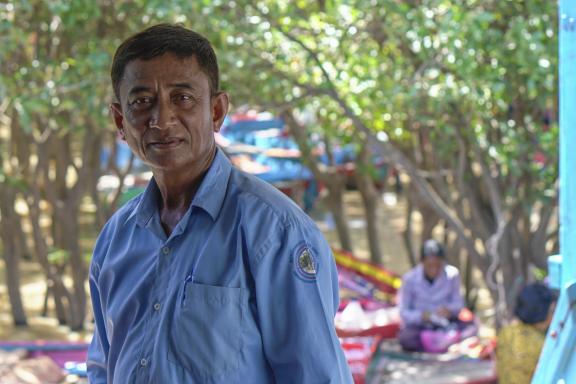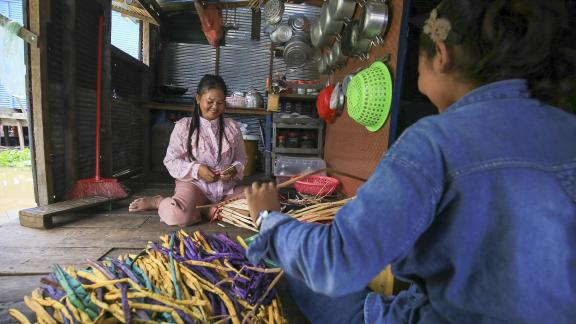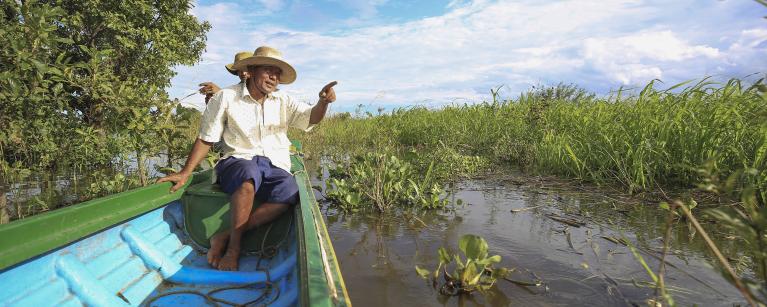HOW CAN FISHING COMMUNITIES ON CAMBODIA’S TONLE SAP LAKE COPE WITH CHANGING RAINFALL PATTERNS, LOWER WATER LEVELS, AND DEFORESTATION?
If you want to see the forest outside Prek Toal in July, it’s best to take a boat. The forest is inundated by Cambodia’s great lake, Tonle Sap, which expands and floods the forest in the rainy season.
Chea Saren visits frequently in his role leading the community fishery committee, which is tasked with protecting this sensitive area. On this day, he blasts along a channel of water in a narrow wooden boat powered by a long-shaft outboard motor, his broad-brimmed hat pulled down firmly. He stops within a special protected area of the flooded forest, where logging and fishing are banned.
The top halves of the trees are visible above the water, which Saren affirms is lower than normal these days. “In the past it has been six to seven meters [19 or 22 feet] deep,” he says, drifting near a stand of trees in the protected area. “Now we are just seeing [the water] come up three or four meters at its highest.” Saren says the lack of water in the lake, attributed to changing rainfall patterns due to climate change, as well as dams in the major tributaries to the lake (like the Mekong River) is affecting fish migration patterns.
Saren also sees the trees as a crucial resource. “The loss of the flooded forest is the greatest threat. The forest holds carbon, it’s a breeding place for fish, and [it] protects us from strong winds.” And when forests are either cut down or not submerged, Saren says fish lose their breeding areas. “This is why species like the giant catfish are disappearing,” he says.
A Sensitive resource
Lack of water, deforestation, and pollution from sewage and agricultural runoff are affecting fishing families living in their floating homes along the lake and rivers flowing into Tonle Sap. It’s the largest lake in Southeast Asia, and produces 60 percent of Cambodia’s freshwater fish.
All the recent changes in the water levels and forest, combined with more
and more restrictive regulations on fishing, make it harder and harder for fishing families to support themselves.
One husband and wife encountered out on the lake near the northern shore said 10 years ago they could catch more than 50 kilos (110 pounds) of fish in a 24-hour period. Today, they say they can’t manage more than five kilos—hardly enough for the family to eat, never mind paying for fuel for their boat’s motor.
Oxfam is working with 15 partners in the western areas of Tonle Sap to support community fishery committees (led by people like Saren) that monitor fishing areas, raise awareness of the environment and the harms of illegal fishing methods, and document violations in reports to local authorities.
The project is also helping schools; is installing water purification centers, eco-friendly toilets, and solar panels in communities; and is helping villages manage solid waste better to reduce the amount of plastic and other garbage in the lake. In the coming years, the project intends to reach more than 200,000 people in the western areas of the Tonle Sap Lake basin.

Sang Kont is the head of the eco-tourism committee in Kampong Phluk, a picturesque town near the tourist center Siem Reap. He says tourism is a viable alternative to fishing and is a way to reduce pressure on the fish population in Tonle Sap Lake. “Climate change has certainly affected the fishing sector. It’s made it hard for fishers to catch fish, it has caused the water levels in the lakes and rivers to be lower and lower. And as population has increased near the lake, there is more and more fishing. Fishing families are having difficulties making a living, and earning enough money.”
Aware of the environment
When Rath Chhay needs raw material for her handicraft business, she finds all she needs right in front of her floating home in Prek Toal village: water hyacinth plants flourish in the river flowing into the Tonle Sap Lake. Chhay and her 15-year-old daughter go out in a small boat early in the morning to collect them. Chhay cuts the stalks off at the base near the water, then hands them to her daughter who trims the leaves off the top and stacks the stalks in the bottom of the boat. They then bring the water hyacinth stalks back to their home and spread them out on the metal roof to dry out.
Chhay uses the dried and dyed stalks to weave place mats, handbags, and other goods she sells to tourist shops in Phnom Penh and Siem Reap, home of the Angkor Wat temple complex. She says some months she can make $250, others less, but in an average year she can clear about $1,000. “I buy rice, drinking water, [and] vegetables, and I pay for electricity,” she says. “I even buy fish.”
Oxfam is working with the Fisheries Action Coalition Team (FACT) to help women like Chhay form handicraft producer groups for training and to connect with markets.
Chhay, 42, says she and her husband used to fish to support their family of seven. When fishing became an unpredictable source of income, she switched to producing handicrafts. Her husband now has a job working for the community fishery committee.
Her business brings her some measure of independence and security, Chhay says. “I feel better, and I don’t have to only rely on my husband’s income. I can count on my income to meet our needs.”
Welcoming tourists
Finding alternatives to fishing not only takes some of the pressure off the fish resources in the lake, it also keeps people from having to migrate in search of work. FACT, Oxfam, and other partners in and around Tonle Sap are forming eco-tourism committees in picturesque towns where visitors can tour the lake and the flooded forest, stay in a floating home, and enjoy fresh local foods while gaining an appreciation of the sensitive environment around the lake.
In Kampong Phluk, about an hour from the tourist center Siem Reap, tourists can visit a 50-foot boat/restaurant at the mouth of a river, have a meal, and go for a boat ride on the lake or board a 14-footer paddled by a local guide for a tranquil four-kilometer tour in the flooded forest.
Sang Kont, 48, leads the eco-tourism committee in Kampong Phluk, an area also affected by climate change. “There is very little water in the flooded forest,” Kont says. “This has been happening for the last two years.”
He and others are putting their faith in their eco-tourism project, but the effort is hampered by the COVID-19 pandemic and lack of clients. In late July, he expressed hopes for more rain, raising the level of water in the flooded forest, and for more visitors to take tours. With help from FACT and Oxfam, Kont says the committee plans to build a visitor center with public bathrooms, a fish-breeding facility, and bird observation areas.
He’s also counting on people in Kampong Phluk to help conserve and protect the fragile natural resources here. “We’re improving the environment,” he says, sitting at a table on the floating restaurant overlooking the lake on yet another sunny day during the rainy season. “We’re replanting trees in the flooded forest to improve the
environment for breeding fish.”
A youth group in Kampong Phluk plays a crucial role in conserving the flooded forest. Oeurn Botha, a 34-year-old
fisherman, is involved in efforts to raise awareness. He and others in town plan to plant 500 trees.
Botha also wants to see more action from countries responsible for climate change. “Those countries causing climate change have big industries and produce a lot of [emissions]; they are causing the issues,” he says. “A country like mine is affected by their actions.
More developed countries need to be aware of what is causing climate change and make sure that what they produce does not harm other countries, and [they should] help us develop alternative solutions to respond to climate change.”
This is part of the project Fisher Folks Making Circular Economy Work for the Western Tonle Sap Lake (FOSTER) led by Oxfam with the financial support from the European Union.
Text by Chris Hufstader and published by Oxfam Closeup 2022.
Photos by: Banung Ou/Oxfam

Rath Chhay says her new business making handicrafts has brought her a measure of financial independence, as she no longer has to only rely on the income her husband can earn. She estimates her handicrafts are bringing in about $1,000 per year, and she hopes that as she can get access to more and different buyers she can increase that income.
